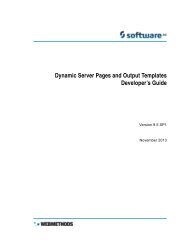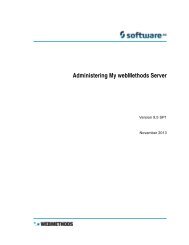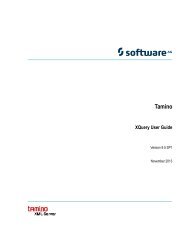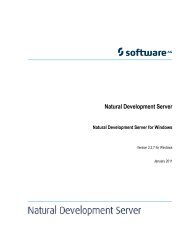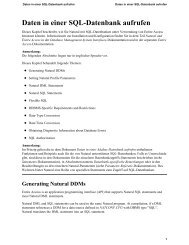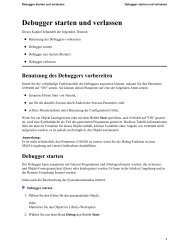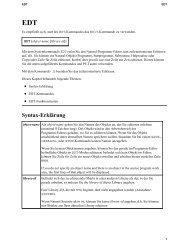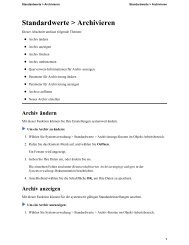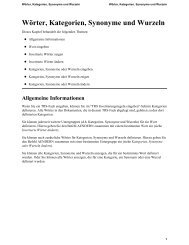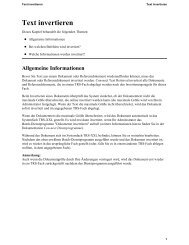Ending Entire System Server - Software AG Documentation
Ending Entire System Server - Software AG Documentation
Ending Entire System Server - Software AG Documentation
You also want an ePaper? Increase the reach of your titles
YUMPU automatically turns print PDFs into web optimized ePapers that Google loves.
Using the <strong>Entire</strong> <strong>System</strong> <strong>Server</strong><br />
This section describes how you can use the <strong>Entire</strong> <strong>System</strong> <strong>Server</strong>.<br />
General<br />
When the <strong>Entire</strong> <strong>System</strong> <strong>Server</strong> is installed, the following macro statement is appended to the<br />
NATPARM module:<br />
NTDB PROCESS,148.<br />
The value 148 in this statement is the target node that Natural will use to identify calls to the <strong>Entire</strong><br />
<strong>System</strong> <strong>Server</strong> (the <strong>Entire</strong> <strong>System</strong> <strong>Server</strong> is delivered with a default target node number of 148. It<br />
can be changed during the installation process, see Installation Step 3). All Natural statements that<br />
use DDMs with DBID 148 are handled as <strong>Entire</strong> <strong>System</strong> <strong>Server</strong> calls. This means that all <strong>Entire</strong><br />
<strong>System</strong> <strong>Server</strong> DDMs must be cataloged with the DBID value that matches the target value used<br />
in the NTDB statement.<br />
The target node specified in the NTDB statement is a logical target ID. You are not limited to using<br />
only an <strong>Entire</strong> <strong>System</strong> <strong>Server</strong> node with the physical target ID of 148. You can use any available<br />
value for each <strong>Entire</strong> <strong>System</strong> <strong>Server</strong> node you install and they are all accessible from the same<br />
Natural. Natural uses the logical target node of 148 simply to recognize a particular statement as<br />
being an <strong>Entire</strong> <strong>System</strong> <strong>Server</strong> statement. The NODE field in each <strong>Entire</strong> <strong>System</strong> <strong>Server</strong> view is used<br />
to direct the call to the desired physical <strong>Entire</strong> <strong>System</strong> <strong>Server</strong> target. Of course, if the NODE field is<br />
not used in a particular call, Natural will direct the call to a node with the same physical target ID<br />
as the logical target ID.<br />
It is recommended that users adopt the practice of always including the NODE field in all of their<br />
<strong>Entire</strong> <strong>System</strong> <strong>Server</strong> calls. This enables them to easily access additional nodes in future without<br />
having to modify existing programs.<br />
The following sequence illustrates how Natural statements are directed at <strong>Entire</strong> <strong>System</strong> <strong>Server</strong>.<br />
A Natural program may contain the statement:<br />
FIND DDM WITH FIELDS<br />
where DDM stands for any view and FIELDS for any sequence of fields in that view. The Natural<br />
nucleus checks whether the specified DDM is cataloged with the <strong>Entire</strong> <strong>System</strong> <strong>Server</strong> DBID.<br />
In the following figure, <strong>Entire</strong> <strong>System</strong> <strong>Server</strong> is abbreviated to ESY.<br />
4<br />
Administration



